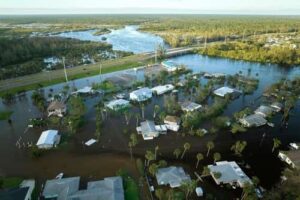Does hurricane insurance cover water damage?
Hurricane insurance is a combination of coverages that when put together, cover the various aspects of storm damage to your home and property.
Your homeowners insurance covers some water damage from hurricanes and other storms. If you lose some shingles off the roof or the window breaks and water gets in and ruins your rug, walls or television, home insurance will cover it.
However, if an overflowing river, creek or heavy rainfall causes a flash flood, that damage is covered by flood insurance, not your homeowners policy. Flood insurance also covers damage to your home from mudslides and storm surges.
“Heavy rains and high seas cause low-lying roads and homes to flood,” Wirtz says. “We have access issues to certain parts of town (and other parts of the island). We know the problem roads and are proactive in closing them prior to a significant event. This hopefully limits vehicular traffic and reduces the possibility of entrapment due to rising and moving water.”
Sometimes, unfortunately, nature takes over. In a major storm, even homes that aren’t considered to be low-lying or in a high-risk flood zone can be flooded.
Is hurricane insurance the same as flood insurance?
While some people call it hurricane insurance, that’s really a misnomer. Hurricane insurance is a combination of coverage you purchase to make sure you are protected in case of such storms. Flood insurance is one of these components, and as the name states, it covers flooding damage during a hurricane.
Make sure your homeowners policy is up to date. You can also look into windstorm insurance for damage caused by wind-related events. If you live in an area prone to these kinds of storms, you can add a rider to your homeowners to cover storm-related damage as well as buy a separate flood policy.
When does flood insurance cover hurricanes?
Flood insurance covers water damage from hurricanes in some but not all cases. Its main job is to cover major flooding that enters your home from the outside, caused by overflowing lakes, rivers, storm surges and excessive rain. On the other hand, if your pipes burst and your house floods, that’s where your homeowners insurance will kick in.
There is a 30-day waiting period for flood insurance to go into effect, so you won’t be covered if you buy when a storm is already on the way. That’s why it’s important to plan ahead.
Many people purchase flood policies through the National Flood Insurance Program (NFIP). Be sure to read the fine print, as there are exclusions for the coverage.
For private flood insurance, there are some exclusions and limitations as well.
The flood has to be a certain size to be considered a flood (covering 2 acres or more). You won’t be reimbursed for damage to your gardens or landscaping or swimming pool. Speaking of swimming pools, if it overflows during the storm and that’s what causes damage to your house, it doesn’t count as “flooding.” Flood insurance also typically doesn't cover finished basements.
Why isn’t flooding covered by home insurance?
Homeowners insurance doesn’t cover flooding because it’s listed as an exclusion on the policy. As for why insurance companies exclude it, the risk and cost are a big part of the reason.
In order to have a full spectrum of coverage for all the types of damage a hurricane can cause, make sure you have a solid homeowners policy in place, purchase flood insurance and look into windstorm insurance.
As storm severity is increasing and flooding is becoming more frequent, flood insurance is highly recommended. Even if you live on a hill or think you are out of harm's way, flooding can affect your home.
How to file an insurance claim for flood damage after a hurricane
If your home was damaged by a hurricane or flooding from a storm, call your insurance company as soon as possible to file a claim. Remember, your homeowners policy covers one type of damage and flood insurance covers flooding. If you have both types of damage, you’ll need to file two claims.
Contact your agent. They will put you in touch with the claims department.
Get all your documents, pictures and proof of damage together. An insurance adjuster will most likely visit your home to assess the extent of the damage. The more you have documented, the better. Before and after pictures are a great way to do this.
Get estimates – in writing – for any repairs or replacement items needed. Work with the adjuster to see if you can get your own repair estimates or need to use companies they recommend. Ask if you can or should make any temporary repairs in the meantime to stave off further damage such as mold and mildew.
If items such as appliances need replacing, provide serial numbers of the ones you lost whenever possible, and get quotes for replacement pieces.
One of the best ways to protect your home and belongings from hurricanes and floods is to be prepared well in advance with solid homeowners insurance and a separate flood insurance policy.
Sources
- FEMA. "What Does Flood Insurance Cover In A Basement?" Accessed July 2023.
- OPIC. "What is flood insurance?" Accessed July 2023.







